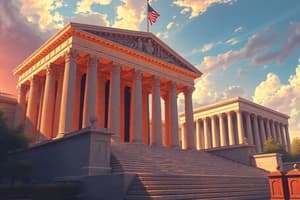Podcast
Questions and Answers
What does the term 'garantismo' in the context of the Italian constitution refer to?
What does the term 'garantismo' in the context of the Italian constitution refer to?
- A framework for international relations
- A focus on economic growth
- A principle of equality and protection of rights (correct)
- Strict adherence to national sovereignty
Which statement accurately reflects a characteristic of many constitutions, as mentioned in the content?
Which statement accurately reflects a characteristic of many constitutions, as mentioned in the content?
- They are typically free of ambiguities.
- They are drafted by a single individual.
- They often prioritize short-term political fixes. (correct)
- They are concise and straightforward.
Which of the following principles is included in the Italian constitution?
Which of the following principles is included in the Italian constitution?
- Mandatory military service for all citizens
- Eight-hour workday limitation (correct)
- Promotion of inequality
- Censorship of educational content
What was a significant critique of the Mexican constitution discussed in the content?
What was a significant critique of the Mexican constitution discussed in the content?
Which countries have the fewest constitutions according to the data provided?
Which countries have the fewest constitutions according to the data provided?
What is a notable comparison made regarding the lengths of constitutions?
What is a notable comparison made regarding the lengths of constitutions?
Which of the following is true about the oldest uncodified constitutions?
Which of the following is true about the oldest uncodified constitutions?
What does the frequency of amendments to constitutions like that of Mexico suggest?
What does the frequency of amendments to constitutions like that of Mexico suggest?
What is a notable characteristic of legal institutions in Russia compared to liberal democracies?
What is a notable characteristic of legal institutions in Russia compared to liberal democracies?
Which element from the 1993 Russian Constitution emphasizes individual rights?
Which element from the 1993 Russian Constitution emphasizes individual rights?
What issue is highlighted regarding the publication of legal rulings in Russia?
What issue is highlighted regarding the publication of legal rulings in Russia?
How do trial procedures in Russia compare to those in liberal democracies?
How do trial procedures in Russia compare to those in liberal democracies?
What was the impact of politics on the legal system in sensitive cases in Russia?
What was the impact of politics on the legal system in sensitive cases in Russia?
What type of government is described as giving greater emphasis to law in general?
What type of government is described as giving greater emphasis to law in general?
What does the phrase 'rule by law' imply in the context of Chinese politics?
What does the phrase 'rule by law' imply in the context of Chinese politics?
What is a significant challenge faced by constitutions in practice as mentioned?
What is a significant challenge faced by constitutions in practice as mentioned?
What was the outcome following the terrorist attacks of September 11, 2001, regarding the US Constitution?
What was the outcome following the terrorist attacks of September 11, 2001, regarding the US Constitution?
How many members of Congress are required to support a constitutional amendment in the United States?
How many members of Congress are required to support a constitutional amendment in the United States?
What might Mexican leaders do regarding constitutional amendments for minor issues?
What might Mexican leaders do regarding constitutional amendments for minor issues?
What does the legal system in China primarily function as?
What does the legal system in China primarily function as?
Which of the following reflects a significant aspect of early Chinese legal history?
Which of the following reflects a significant aspect of early Chinese legal history?
Flashcards
Constitution
Constitution
A set of fundamental principles and rules that establish the structure, powers, and limits of a government, as well as the rights of citizens.
Constitutional Courts
Constitutional Courts
Legal institutions designed to uphold and interpret a country's constitution, ensuring its provisions are respected and applied equally.
Gap between constitutional ideals and practice
Gap between constitutional ideals and practice
The gap that exists between the ideals outlined in a constitution and the way those principles are actually implemented in practice.
Regime Change
Regime Change
Signup and view all the flashcards
Reconstruction
Reconstruction
Signup and view all the flashcards
Challenge of new constitutions:
Challenge of new constitutions:
Signup and view all the flashcards
Restrictions on new governments
Restrictions on new governments
Signup and view all the flashcards
Political distrust and ineffective governments
Political distrust and ineffective governments
Signup and view all the flashcards
Constitutional 'fudges' and 'truces'
Constitutional 'fudges' and 'truces'
Signup and view all the flashcards
Garantismo
Garantismo
Signup and view all the flashcards
Codified Constitution
Codified Constitution
Signup and view all the flashcards
Uncodified Constitution
Uncodified Constitution
Signup and view all the flashcards
Constitution Amendments
Constitution Amendments
Signup and view all the flashcards
Constitutional Amendment Process
Constitutional Amendment Process
Signup and view all the flashcards
A Constitution's 'Radical and Progressive' Nature
A Constitution's 'Radical and Progressive' Nature
Signup and view all the flashcards
Gap between constitutional ideals and reality
Gap between constitutional ideals and reality
Signup and view all the flashcards
New constitution challenges
New constitution challenges
Signup and view all the flashcards
Ineffective government due to distrust
Ineffective government due to distrust
Signup and view all the flashcards
Islamic constitutionalism
Islamic constitutionalism
Signup and view all the flashcards
Authoritarian rule through law
Authoritarian rule through law
Signup and view all the flashcards
Constitutional Ideals vs. Practice
Constitutional Ideals vs. Practice
Signup and view all the flashcards
Study Notes
Constitutions and Courts: An Overview
-
Constitutions are critical for understanding governance structures and citizen rights. They outline government power, institutions, and citizen rights.
-
Courts ensure constitutional principles are followed. They interpret and apply laws for fairness and equal application.
-
A constitution isn't a static document. It defines government goals but has gaps between ideals and practice. Constitutions vary significantly in length and efficacy; there's no fixed template.
-
Constitutions set out a power map, specifying political principles and rules. Understanding governments entails knowing these rules and how they're changed or amended.
-
Courts serve to determine constitutional validity. Analyzing the relationships between supreme courts, constitutional courts, and judicial activism is crucial.
-
Courts play roles in recruitment, tenure, and judicial independence. The systems of common law, civil law, and religious law are key to understanding how courts interact with constitutions.
-
Authoritarian regimes often use constitutions as facades or largely ignore them.
The Character of Constitutions
-
Most constitutions share common elements, usually beginning with a preamble outlining state ideals. The core lays out governmental structure and how officials are chosen. A bill of rights details citizen rights, and an amendment procedure is usually described.
-
Constitutions are either codified (one document) or uncodified (multiple sources). Codified constitutions tend to be more easily referenced, while uncodified constitutions often contain elements of multiple sources, including statute law, common law, European law, and customs.
-
The rule of law prioritizes laws over arbitrary power. Legal systems, and their applications, differ significantly between countries.
-
Constitutions, while often broad in their initial goals, provide framework for policies, powers, rights, and government structures.
Durability of Constitutions
-
Constitution longevity is often measured, but quality, not age, is arguably more important.
-
Constitutions create space for judicial review to enforce and uphold specified rights and freedoms. A degree of idealism exists within all constitutions, but these claims often can't be verified empirically, especially concerning their practicality.
-
A gap often arises between stated constitution ideals and real-world practices. Comparing what is said to what happens in practice is key to assessing constitution effectiveness.
Judicial Activism
-
Judicial intervention in public policy has increased since 1945. This is seen as a shift from judicial restraint.
-
Four key factors explain this trend: The decline of the left has afforded courts a greater scope, the emphasis on regulation demands court intervention, global legal norms provide bases for judging national laws, and prestige continues for judicial structures.
Constitutional Courts
-
Specialized courts, often standing apart from ordinary courts, exist in many countries. They focus on constitutional issues.
-
The function of judicial review involves evaluating government actions against the constitution.
Comparing Supreme Courts and Constitutional Courts
-
Supreme courts usually take a concrete review approach by evaluating actions in the context of specific cases.
-
Constitutional courts favor abstract review, offering advisory opinions regarding laws' constitutionality without needing a specific case example.
Studying That Suits You
Use AI to generate personalized quizzes and flashcards to suit your learning preferences.




